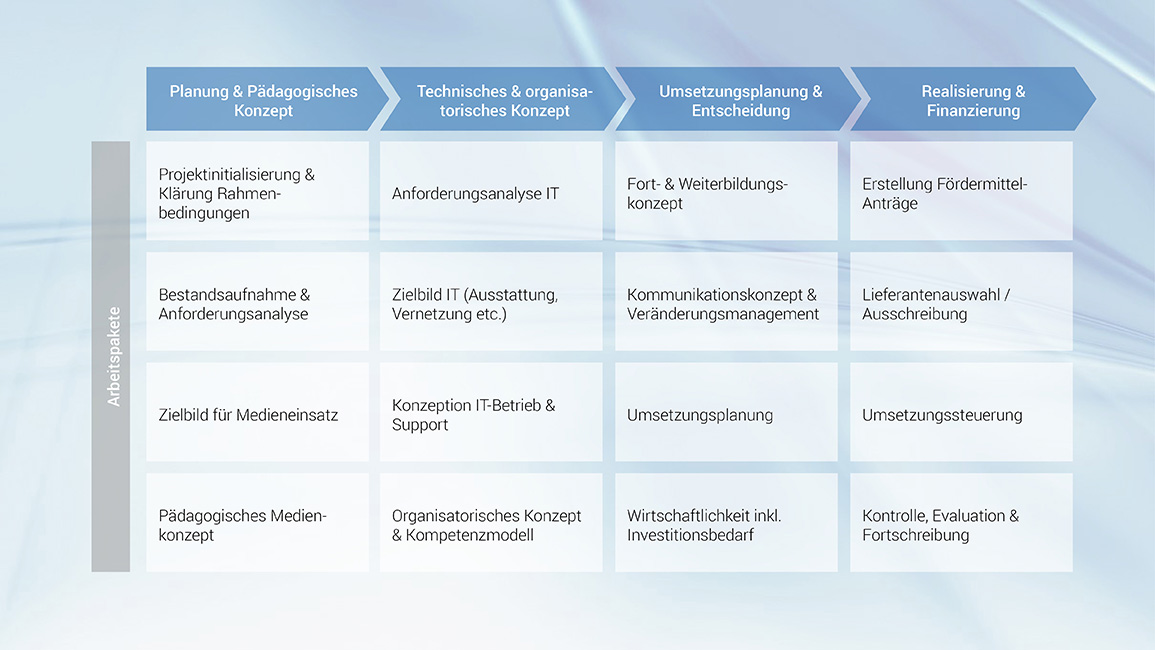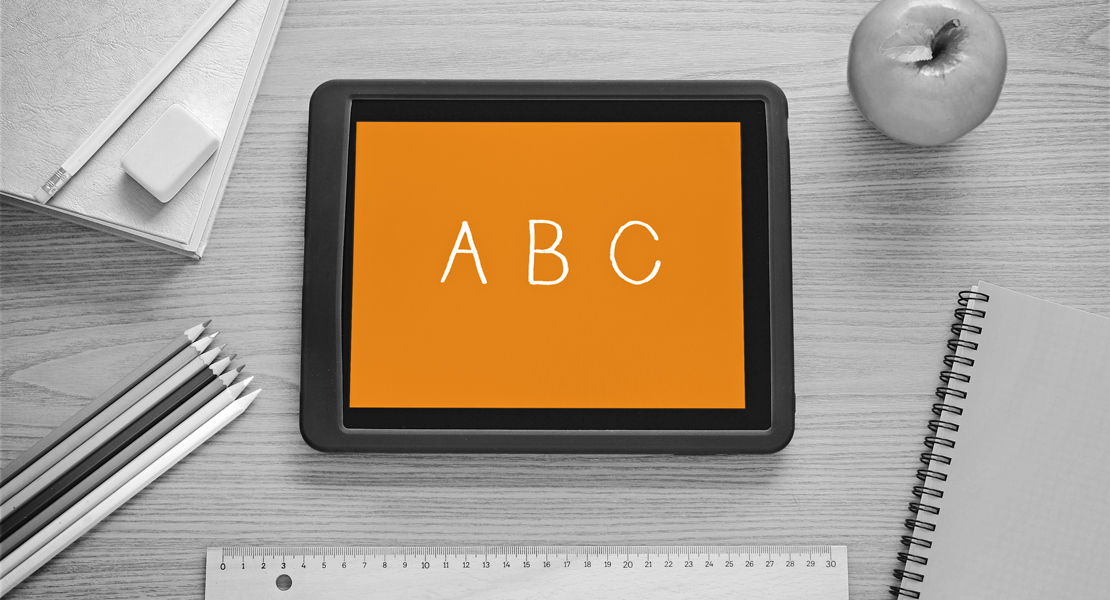The Corona crisis has shown schools the opportunities but also the problems of digitalization. Some schools have reacted amazingly quickly, switching to teaching via "Teams" or "Zoom" and making a virtue out of necessity with a lot of released energy. Many teaching staffs, some of whom were initially skeptical, are now in no doubt that the digital transformation is very important. Nevertheless, there is a huge implementation problem, the magnitude of which can be seen in the use of funds from the "DigitalPakt" to date.
Through the "DigitalPakt Schule" (Digital Pact for Schools), the federal government is providing five billion euros through 2024 for investments in school infrastructure. In addition, 550 million euros will be provided by school authorities in the federal states. According to a survey by Bayerischer Rundfunk, just less than 1 percent of this amount (around 40 million euros) had been approved as of February. The intentions and the magnitude of the budget framework are very welcome, but the calls are slow.
"No equipment without a concept"
In principle, it is the right decision to link funding applications to media development plans. After all, many an acquisition of digital equipment turns out to be a bad investment without a planned deployment concept. In the past, for example, a large number of uninstalled IT devices were left gathering dust in the basement, or interactive whiteboards were installed but did not work, or the IT equipment was not used at all or not used properly due to a lack of training. Not to mention a lack of digital learning content. The media development plans, which are a prerequisite for financial support, are intended to force schools and school boards to take the planned approach that is necessary to remedy such shortcomings. Only if the development of digital learning infrastructures is based on pedagogical concepts will the investments pay off in the long term. The motto is "technology follows pedagogy."
Accordingly, the core of every media development plan is the pedagogical concept, in which the objectives and the didactic and pedagogical implementation are recorded within the framework of a subject, media and method curriculum, depending on the school profile. The technical concept describes the room concepts, the digital learning environment and equipment, and the IT operation and support concept. The third component is the continuing education concept, which includes continuing education planning for the school staff as well as the creation of a support structure and networking and exchange with other schools. In a fourth, organizational component, user regulations, responsibilities, scheduling, and the financing concept with controlling and reporting are defined.
The crux of the media development plan
The condition "No equipment without a concept" is well-intentioned, but the creation of a media development plan is firstly quite complex and secondly only a first step in the digital transformation process. Many school boards and schools rightly feel left to their own devices. After all, their job is not to plan and manage complex IT projects, set up and operate an IT department, create an IT support concept or manage an external IT service provider.
It is therefore not surprising that there are huge gaps between the professional target image and the current situation. Support concepts for IT operations are often completely neglected. It is not uncommon for IT support to consist of the IT teacher, who tries desperately and with a lot of heart and soul to somehow ensure IT operation and support together with students from the IT club. It's no wonder that teachers can't reach anyone when IT problems arise, that solutions are a long time coming, and that this leads to frustration for everyone involved.
In the industry, it has long been standard practice for every IT user to have access to a professional hotline with an 80 percent "first fix rate": That is, as a teacher, you call the hotline and in 80 percent of the cases, the support employee:in connects to the end device and helps solve the problem "remotely" while still on the phone. On the one hand, this support is efficient and cost-effective, since it can be operated by industrially organized call centers at a low unit cost per support ticket. On the other hand, it ensures high customer satisfaction because the teacher almost always receives help immediately, as well as a low loss of productivity - because a teacher who spends hours trying to get to grips with IT cannot perform her actual, pedagogical tasks during this time. Even teachers who take on IT support on the side for a few relief hours cannot fulfill their teaching duties full-time, which only supposedly saves costs. There is already a need for action here in the media development plans to think ahead to the right solutions. However, the entire life cycle and the associated complexity are usually criminally underestimated and further overburden teachers who are already stretched to the limit.
It is no shame at all that schools and smaller school boards are completely overwhelmed with such issues. It is not uncommon for them to be left alone, although it should be clear that their core competencies lie neither in the creation of a support concept nor in the implementation of IT support. Instead, there is an urgent need for alliances of school boards or higher-level authorities at the state level to work with their IT service providers to provide holistic solutions, including consulting support and the application of best practices.
For cost reasons alone, bundling at a higher level makes sense because significant economies of scale can be achieved in the purchase of hardware and software or IT support contracts. Concluding the outlined support contracts for IT support is a complex undertaking that relies on highly professional IT specialists and lawyers.
The road to the digital classroom
When developing an individual media development plan, it is advisable to proceed in four steps. Since the procedure is extensive, exchanges should be sought with other schools that have already successfully submitted a media development plan for funding and have even begun to implement it. Sample media development plans can greatly facilitate and accelerate the creation process.
- Planning and pedagogical concept: The first step is to coordinate with all stakeholders and set up project management. Responsibilities must be clarified and assigned according to the chapter structure of the media development plan. As part of an inventory, the school profiles such as framework data, student bodies, staff structures, special features and the current use of media are recorded. The requirements and wishes of school principals, teachers and students for future IT-supported instruction are recorded, analyzed and evaluated. On this basis, a target image for the future use of media is created. The pedagogical media concept forms the core of the media development plan, from which further considerations and concepts are derived.
- Technical and organizational concept: Based on the pedagogical requirements defined in the first step, the need for IT infrastructure and equipment is analyzed. The desired target image for IT must be clearly defined, taking into account data protection and funding guidelines on how to prioritize open source offerings. The technical concept is also accompanied by a concept for IT operation and support. The competencies of the teaching staff and the organizational measures required in connection with the use of media in the classroom, such as netiquette and user regulations, must also be clarified and defined here.
- Implementation planning and decision: In the third step, a training and professional development concept is created, which is an important third component of a media development plan alongside the pedagogical and technical concept - because good IT equipment is of no use if teachers cannot use it or can only use it partially and they see the digital devices as a hurdle instead of an enrichment for their teaching. Communication to all stakeholders and accompanying change management are equally important to ensure that the implementation of the media development plan later succeeds. Teachers must be relieved of concerns and inhibitions about using digital media. A concrete roadmap for implementing the individual steps for each school must be defined. Finally, the investment requirements must be determined in terms of cost-effectiveness and the financing planned, depending on the financing rules of the "DigitalPakt" and the budget of the school authority. Before the media development plan is submitted, careful quality assurance should take place based on the release criteria depending on the federal state. Finally, approval is given by the school board.
- Implementation and financing: In the fourth and final step, the school authority submits the subsidy application to the respective central state office. If the funding is approved, the tenders can follow and suitable suppliers can be selected. It should be noted that media development planning is an ongoing process. The media development plan is part of school development and must be monitored, evaluated and updated on an ongoing basis. With the help of online surveys and open discussions in the teachers' conference, the success of the media development plan can be measured and optimized.

The way forward
The problem that remains is the renewal/redesign of curricula and learning content. Even with the successful implementation of an infrastructure with WLAN, interactive whiteboards, mobile devices and the right media curriculum, the potential of digitalization is far from exhausted.
Like an iceberg, the true potential lies hidden beneath the surface of the water. Class sizes of today's not infrequent 30 students must be cut at least in half to ensure optimal conditions for learning. It is clear from many pedagogical studies and training courses in the industry that small classes of 10 to 15 students enable significantly more effective learning and also relieve the teachers. Until now, such class sizes have always failed due to a theoretically required doubling of the number of teachers. However, teachers are not the right resource for frontal teaching and the mere imparting of knowledge. Studies also show this. Computer-based training (CBT) can impart and, above all, control certain learning content much more efficiently and quickly. With a CBT, which is completely automated without a teacher, a lot of effort can be put into a good and entertaining knowledge transfer in advance. Even elaborate productions are worthwhile, since the content is not only used once in an individual lesson, but can be used nationwide. The knowledge acquired in this way can be closely monitored in individual, small steps and by means of immediately following control questions, without the solution of which the students cannot proceed to the next level. This self-directed/autonomous learning ensures a high level of concentration and at the same time an individual learning speed. This level of self-direction, concentration and individual pace cannot be achieved in a classroom setting. CBTs and other digital formats are by no means only suitable for learning vocabulary, for example, but can also be used for broader knowledge transfer.
Teacher capacities freed up by such automation allow for a reduction of class sizes and a better focus on communicative and interactive forms of learning, which lead to a higher frequency of speaking, e.g. in foreign language classes, and promote social-communicative competencies of the students, such as teamwork, discussion skills, value transmission in the group, and the important development of active vocabulary.
Both teachers and students would benefit from partial automation through CBTs and other digital formats. Of course, suitable content must first be created and integrated into completely restructured curricula. In addition, questions of supervision must be rethought, so there is still a long way to go here. But it can succeed if higher-level authorities, with the help of "lighthouse schools," test such concepts and invest courageously in bold solutions together with textbook publishers. The digital possibilities now exist. It is therefore only a question of time before the digital possibilities can be used to the benefit of teachers, students and parents.
How do we get faster?
There is certainly no patent remedy for acceleration. However, greater support for school authorities and schools is urgently needed. Depending on the federal state, it may be advisable to bundle and build up additional competencies at a higher level in order to better support schools and school authorities. For example, it is conceivable to establish public-law institutions (AöRs) that actively support schools and school boards in the development of media development plans and the subsequent digital transformation. These should be equipped with budgets, clear management models, project management competencies and digitalization best practices. They could also be used to realize significant purchasing advantages and, for example, better bundle framework agreements with service providers for IT operations at schools or for consulting support, so that school boards and schools can access services promptly and cost-effectively. In addition to building up expertise and project management capabilities in schools, these entities could also be used to better drive and fund innovation, such as the aforementioned "lighthouse schools" and the development of modern learning formats together with textbook publishers in innovation labs. Last but not least, this would accelerate the smooth drawdown of funds and allow them to be focused more specifically on innovative school models.
The article has also been published in condensed form at: „Wegweiser – Verwaltung der Zukunft - VdZ.org“ (in German)







